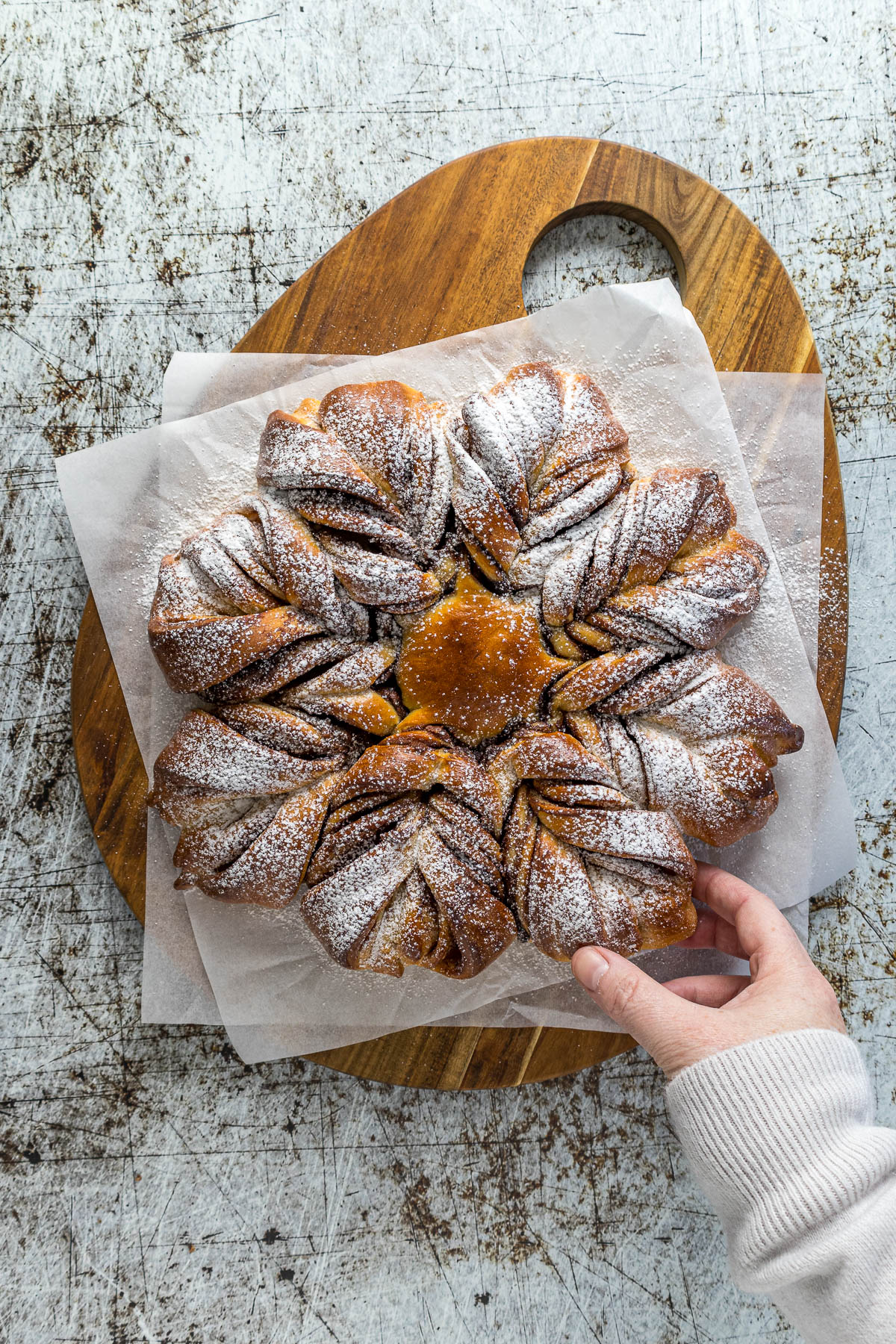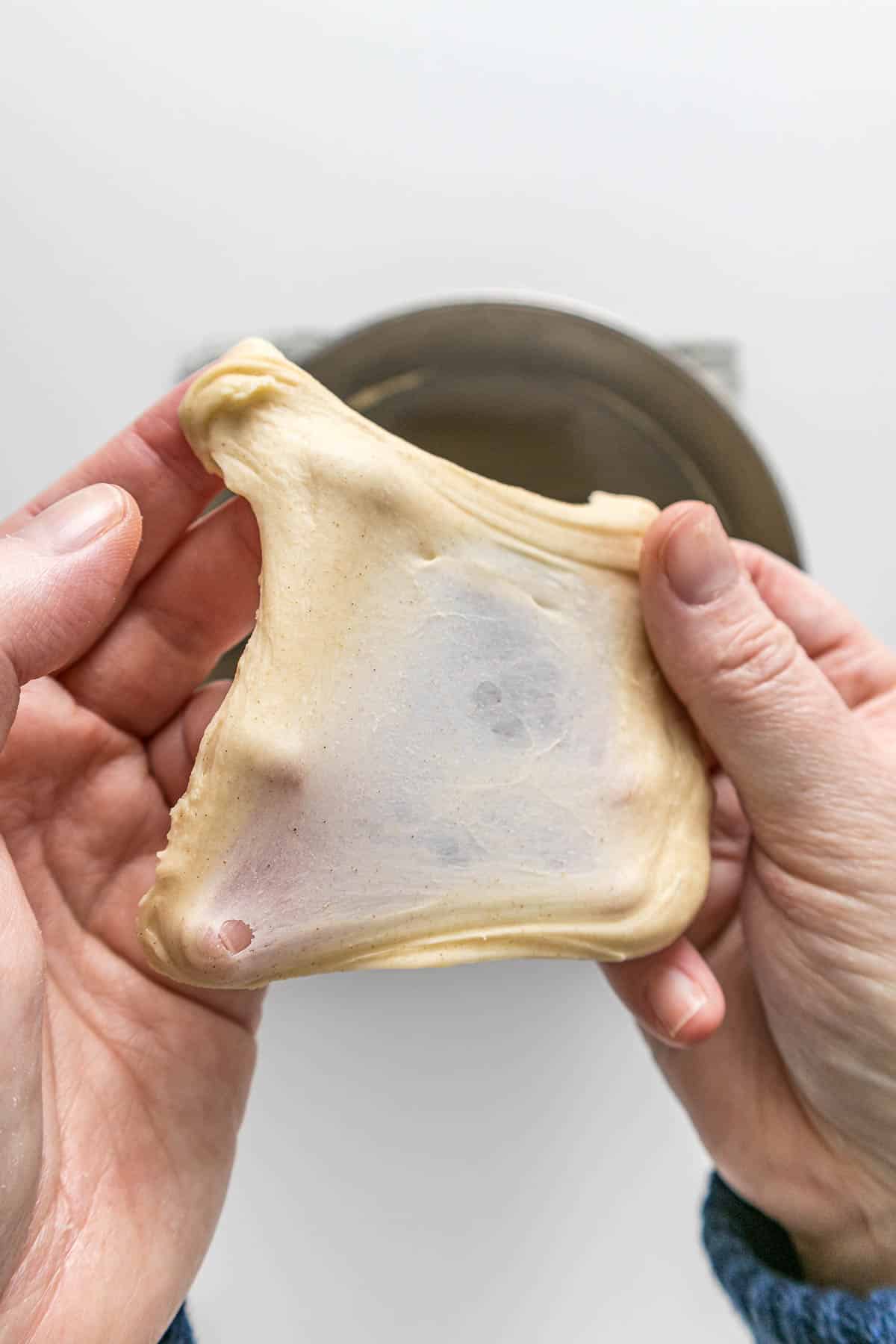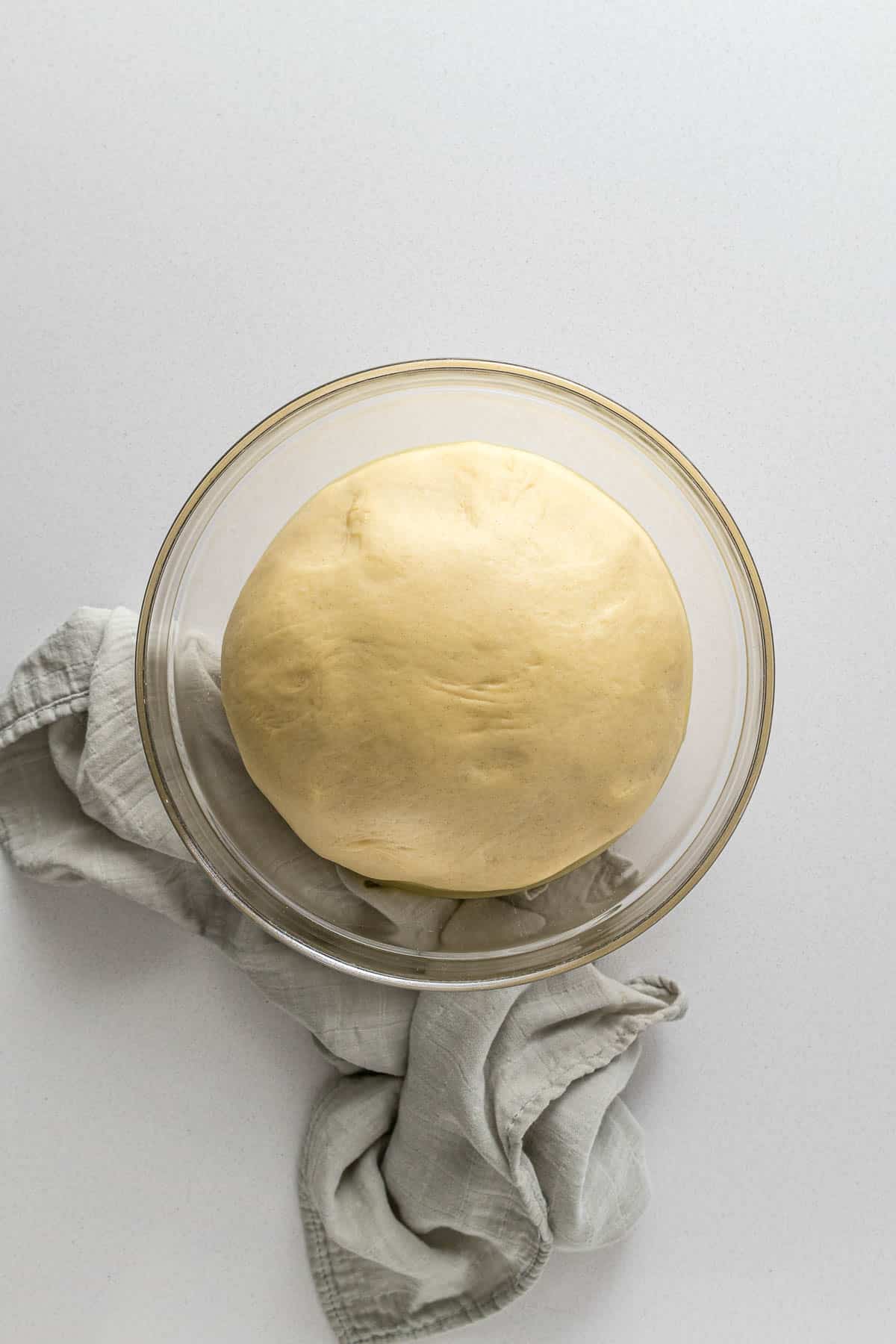This delicious tender Nutella bread consists of an enriched bread dough that is filled with a rich Nutella chocolate-hazelnut spread. Dust the warm Nutella star bread with powdered sugar before serving.
This Nutella bread recipe is perfect for the holiday season and will make a great addition to the brunch table.

Jump to:
Recipe Development
The recipe development for this Nutella bread was pretty simple. I decided to start with the bread dough used in my apple pie cinnamon rolls and moved on from there. I made a few adjustments, to suit this recipe, but not many.
My gut said to make this a Nutella star bread because Nutella or chocolate hazelnut spread can be quite slippery. But then I was like, maybe I could make a braided wreath...and after several attempts of making a wreath, I went back to my original idea, and honestly preferred the results.

Ingredients
Here are notes on the ingredients used, please refer to the recipe card for full quantities.

This is an enriched dough, so it contains butter, eggs, and milk. These all add softness and richness to the bread.
- Butter - I used New Zealand butter which is about 82% butterfat, which is very similar to European or Irish Butter. This can be substituted with baking margarine. I used soft butter for this recipe.
- I used size 6 New Zealand eggs, the same size as an Australian or South African large egg, or a US/European medium-sized egg. I like to use a room-temperature egg.
- I used whole or full-fat milk for this bread, but you can use a lower-fat variety. If you want to use plant-based milk, then soy is probably the best bet.
Yeast - I used active dry yeast, which needs rehydration. Which is why I hydrate it in milk with sugar (to give it a kickstart). If you use instant yeast you can skip this step and toss all the dough ingredients into the mixer and go. A packet of yeast is about 2 ¼-2 ½ teaspoons of yeast or 7 grams.
White sugar gives the yeast a kickstart to the fermentation process. This can be replaced with light or dark brown sugar.
Flour - I made this recipe with both all-purpose or plain flour or standard-grade flour, as well as with high-grade/bread flour. And honestly, the plain or all-purpose flour works better.
Salt is a crucial ingredient in bread. It helps control the rate of yeast fermentation, strengthens the gluten, improves the flavor, and also plays a role in the color of the crust. I use table salt, one teaspoon of table salt equals 1.5 teaspoons of Morton Kosher Salt equals 2 teaspoons of Diamond Crystal.
Nutella Spread or a generic chocolate hazelnut spread (I find the local Pam's and Woolworths variety works perfectly fine for half the price).

Weighing and Measuring Ingredients
Weighing ingredients with a kitchen scale is more accurate than using measuring cups. All my recipes are developed and tested using grams only.
However, I have activated the metric-to-cup conversions. Click "USA/Cups" or "metric" for your preferred measurements. For these conversions, cups are equal to 240mL/8 fl oz, tablespoons are 15mL and teaspoons are 5mL.
Step-By-Step Instructions
Step 1 - Proof the yeast. Warm up the milk until it is lukewarm. Add in the sugar and the yeast. Stir together and let sit until the milk becomes foamy and creamy looking.

Step 2 - Combine ingredients. In the bowl of your stand mixer (with the dough hook attachment) combine the dry ingredients (flour and salt), stir together, then pour in the yeast mixture, add the egg, and the soft butter. Mix on a low speed to form a shaggy dough.
Step 3 - Knead. Knead the bread dough on a low-medium speed (I always use speed 2 on my Kitchen Aid), for 10 minutes until you have reached the window-pane test. If the dough is looking a bit wet, add in the additional flour 2 tablespoons at a time. I find that I sometimes only need half the additional flour, and other times all of the flour. Scrape down the sides of the bowl when necessary.
Step 4 - Window Pane Test. To check the dough, take a small piece, and gently stretch it out between your fingers until the dough is thin and you can see light through it. If the dough tears easily, it needs to be kneaded further.

Step 5 - Proof the dough. Place about 1 tablespoon of oil in a large bowl. Shape the dough into a ball, then place it into the lightly greased bowl, turning the dough a few times to cover it in oil. Cover the dough with plastic wrap or cling film, and cover with a clean kitchen towel. Allow the dough to proof in a warm place for an hour to an hour and a half, or until the dough has doubled in size.


Step 6 - Shape the dough. Once the dough has been proofed, punch down the dough, then turn it out onto a clean work surface. Divide the dough into 4. For each portion of dough, pick up the edges, and pull to the middle to create a round-ish shape. Then turn the ball over onto its seam, and create a little cage with your fingers over the dough swirling loosely around the dough until you have a nice round roll. The surface should have very little flour, if any, as we are using the stickiness of the surface to create tension on the dough.
Step 7 - Roll out the dough. Line a large baking tray or baking sheet with parchment paper (I used a Jelly Roll pan). Roll the first ball into a thin disk about 9 inches or 23cm across. Sometimes the dough will resist being stretched and rolled, if you hit any resistance, let the dough sit for a minute or two, this allows the proteins to relax, and then continue. Repeat for all the balls.
Step 8 - Add the filling. Place the first piece of dough onto the prepared baking tray. Then spread ⅓ of the Nutella spread on the disk, leaving about 0.5 cm or ⅛ inches spread free. Place the second disk of dough over the Nutella, trying to line up the edges as best as possible. Spread with the second ⅓ of Nutella again leaving about 0.5 cm or ⅛ inches spread free. Repeat with the third disk of dough. Then place the final fourth disk of dough over the Nutella. Gently pinch the edges together.

Step 9 - Cut the dough. Place a 7cm or 3-inch round cookie cutter into the center of the dough. Then using a sharp knife or bench scraper, cut from the cookie cutter to the edge to create 4 equal portions. Repeat for each portion to create 8, and then a final time to create 16 portions in total.
NOTE - Some people like to trim off the outer inch or 2cm of the dough before they begin twisting the bread into a big star. I didn't bother, and think the bread comes out great as it is.

Step 10 - Twist the dough. Take two pieces of dough right next to each other, one in each hand, and lift and twist the dough 3 times away from each other. Pinch the outer edges together.

Step 11 - Final rise. Cover the top of the now gorgeous star with some cling film, plastic wrap, or a clean tea towel. Allow to rise for about 30 minutes, or until the star is nice and puffy. You will know when it's ready to be baked when you poke the edge of the bread, and the indent jumps back about half the way.
Step 12 - Preheat. While the star is rising, preheat the oven to 190°/375°F.
Step 13 - Egg wash. Just before you pop the bread into the oven, beat together an egg and a tablespoon of water or milk. Brush the egg wash over the bread.
Step 14 - Bake. Bake the bread in the preheated oven for 25-30 minutes. The bread should be a nice deep golden brown when done. The internal temperature will be about 90°C/190°F.
Step 15 - Cool the bread. Allow the bread to cool on the tray for 15 minutes before lifting it onto a wire rack to cool further for at least 20 minutes. I lift my bread using the parchment paper.
Step 16 - Serve warm. Dust the bread by sieving about 1 to 2 tablespoons of powdered sugar (icing sugar) over the top of the bread. Then let everyone tear off a piece of bread.
Note - this bread is great while still warm and at room temperature.

Expert Tips for This Recipe
Kneading by Hand
If you don't have a stand mixer, you can make this bread by hand. If making the bread by hand do the following:
- Weigh the flour into a large mixing bowl, stir through the flour. Beat the egg into the yeast-milk mixture and add the wet ingredients (including the soft but not melted butter) to the dry ingredients. Stir through until you have a shaggy dough, then let the dough rest for 15 minutes. This allows the flour to hydrate and stimulate gluten formation before you begin kneading.
- Add in butter while kneading about 1 tablespoon at a time.
- Add the additional flour as needed, and knead until you get to the window pane stage and continue with the instructions.
Poke Test
The poke test is a very simple way in which to figure out if the dough is finished proofing.
- Underproofed: Poke and the dough immediately pops back.
- Overproofed: You poke the dough and it doesn't pop back at all.
- Perfectly proofed: You poke and the dough pops back but still leaves an indentation.
Ovens and Air-Fryers
The temperatures stated are for conventional ovens. For convection, fan-forced, fan-assisted, or air-fryers, the temperature must be reduced by 20°C/25°F.
For baking, make sure the oven is fully preheated, and that the rack is in the middle of the oven. Open the oven as little as possible. For best baking results use an oven thermometer.
Remember that all ovens work slightly differently and bake times may need to be adjusted for your specific oven.
Storage and Freezing
Store left-over Nutella bread in an airtight container for 3 days in a cool, dry place. To freshen up the bread, pop it into the microwave for 10-20 seconds.
Other Recipes You May Like

Rate & Review!
If you made this recipe, please leave a star rating! It gives my readers and me helpful feedback. If you want more recipes, subscribe to my newsletter, and follow me on Instagram, Pinterest, and Facebook!
Recipe Card

Nutella Bread
Equipment
- Baking Tray
- Stand Mixer
Ingredients
- 1 cup milk (lukewarm)
- ¼ cup white granulated sugar
- 2½ teaspoon active yeast *Note 1
- 3½ cups plain flour *Note 2
- 1 teaspoon salt
- 4 tablespoons butter (soft)
- 1 egg (medium/large *Note 3)
- ½ cup plain flour (additional where required)
- 1 tablespoon neutral oil
- ½ cup Nutella
- 1 egg (medium/large for the egg wash)
- 1 tablespoon milk (or water for the eggwash)
- 1-2 tablespoons icing sugar (powdered sugar)
Instructions
- Warm up the milk until it is lukewarm. Add in the sugar and the yeast. Stir together and let sit until the milk becomes foamy and creamy looking.1 cup milk, ¼ cup white granulated sugar, 2½ teaspoon active yeast
- In the bowl of your stand mixer (with the dough hook attachment) combine the dry ingredients (flour and salt), stir together, then pour in the yeast mixture, add the egg, and the soft butter. Mix on a low speed to form a shaggy dough.3½ cups plain flour, 1 teaspoon salt, 4 tablespoons butter, 1 egg
- Knead the bread dough on a low-medium speed (I always use speed 2 on my Kitchen Aid), for 10 minutes until you have reached the window-pane test. If the dough is looking a bit wet, add in the additional flour 2 tablespoons at a time. I find that I sometimes only need half the additional flour, and other times all of the flour. Scrape down the sides of the bowl when necessary.½ cup plain flour
- To check the dough, take a small piece, and gently stretch it out between your fingers until the dough is thin and you can see light through it. If the dough tears easily, it needs to be kneaded further.
- Place about 1 tablespoon of oil in a large bowl. Shape the dough into a ball, then place it into the lightly greased bowl, turning the dough a few times to cover it in oil. Cover the dough with plastic wrap or cling film, and cover with a clean kitchen towel. Allow the dough to proof in a warm place for an hour to an hour and a half, or until the dough has doubled in size.1 tablespoon neutral oil
- Once the dough has been proofed, punch down the dough, then turn it out onto a clean work surface. Divide the dough into 4. For each portion of dough, pick up the edges, and pull to the middle to create a round-ish shape. Then turn the ball over onto its seam, and create a little cage with your fingers over the dough swirling loosely around the dough until you have a nice round roll. The surface should have very little flour, if any, as we are using the stickiness of the surface to create tension on the dough.
- Line a large baking tray or baking sheet with parchment paper (I used a Jelly Roll pan). Roll the first ball into a thin disk about 9 inches or 23cm across. Sometimes the dough will resist being stretched and rolled, if you hit any resistance, let the dough sit for a minute or two, this allows the proteins to relax, and then continue. Repeat for all the balls.
- Place the first piece of dough onto the prepared baking tray. Then spread ⅓ of the Nutella spread on the disk, leaving about 0.5 cm or ⅛ inches spread free. Place the second disk of dough over the Nutella, trying to line up the edges as best as possible. Spread with the second ⅓ of Nutella again leaving about 0.5 cm or ⅛ inches spread free. Repeat with the third disk of dough. Then place the final fourth disk of dough over the Nutella. Gently pinch the edges together.½ cup Nutella
- Place a 7cm or 3-inch round cookie cutter into the center of the dough. Then using a sharp knife or bench scraper, cut from the cookie cutter to the edge to create 4 equal portions. Repeat for each portion to create 8, and then a final time to create 16 portions in total. *Note 4
- Take two pieces of dough right next to each other, one in each hand, and lift and twist the dough 3 times away from each other. Pinch the outer edges together.
- Cover the top of the now gorgeous star with some cling film, plastic wrap, or a clean tea towel. Allow to rise for about 30 minutes, or until the star is nice and puffy. You will know when it's ready to be baked when you poke the edge of the bread, and the indent jumps back about half the way.
- While the star is rising, preheat the oven to 190°/375°F.
- Just before you pop the bread into the oven, beat together an egg and a tablespoon of water or milk. Brush the egg wash over the bread.1 egg, 1 tablespoon milk
- Bake the bread in the preheated oven for 25-30 minutes. The bread should be a nice deep golden brown when done. The internal temperature will be about 90°C/190°F.
- Allow the bread to cool on the tray for 15 minutes before lifting it onto a wire rack to cool further for at least 20 minutes. I lift my bread using the parchment paper.
- Dust the bread by sieving about 1 to 2 tablespoons of powdered sugar (icing sugar) over the top of the bread. Then let everyone tear off a piece of bread. This bread can be served warm or at room temperature.1-2 tablespoons icing sugar
Notes
- I used active dry yeast, which needs rehydration. Which is why I hydrate it in milk with sugar (to give it a kickstart). If you use instant yeast you can skip this step and toss all the dough ingredients into the mixer and go. A packet of yeast is about 2 ¼-2 ½ teaspoons of yeast or 7 grams.
- I made this recipe with both all-purpose or plain flour or standard-grade flour, as well as with high-grade/bread flour. And honestly, the plain or all-purpose flour works better.
- I use New Zealand size 6 eggs are around the same size as an Australian/South African Large or a US/European medium.
- Some people like to trim off the outer inch or 2cm of the dough before they begin twisting the bread into a big star. I didn't bother, and think the bread comes out great as it is.
Storage and Freezing
Store left-over Nutella bread in an airtight container for 3 days in a cool, dry place. To freshen up the bread, pop it into the microwave for 10-20 seconds.Nutrition
Nutrition information is an estimate. If scaling the recipe remember to scale your cook and bakeware accordingly. All temperatures stated are conventional, unless otherwise stated. Recipes tested in grams and at sea level.






Comments
No Comments